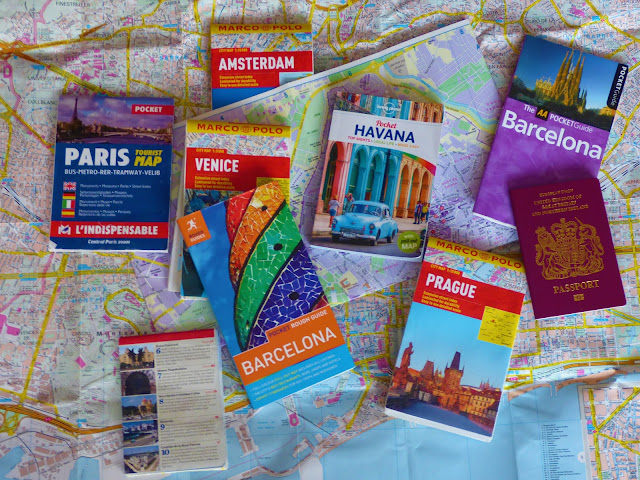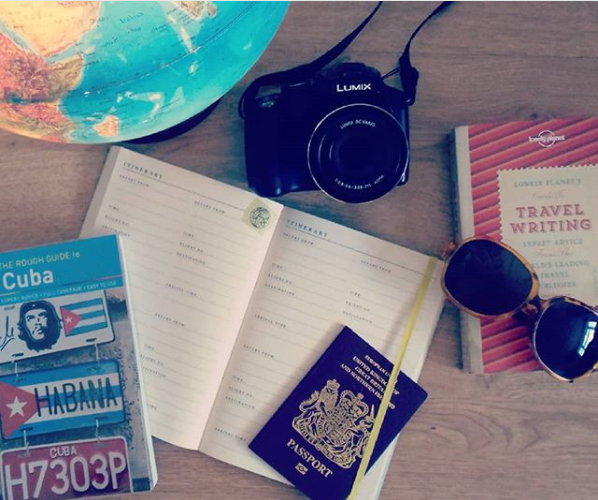When you come back from a trip, do you get rid of your maps and guidebooks, or do you keep them as mementos and souvenirs?
I recently threw this question out on social media, and wasn't at all surprised at the result. Like me, most of you are absolute hoarders when it comes to travel paraphernalia (there is one monster among you, but I won't name names).
But why do we keep them? A map of the souks of Marrakech is not going to be any use in the Kent countryside, and a plan of the Barcelona Metro offers no solution to the trials and tribulations of the London Underground. They sit there, gathering dust on our already overstuffed bookshelves in space-deprived flats, surviving the many clear outs, while their lesser bedfellows are reduced to the charity shop pile.
In my opinion, a map book is the best storyteller a traveller can have, equal in importance to the photos when looking back on the trip. Here's something I wrote about the map I took to Venice.
A ode to my map of Venice
I bought you from WHSmith in Victoria station, about a week before we were due to fly. I barely looked at you at all to be honest, until we got on the plane, but I checked my bag time and time again to make sure you were there, the knowledge you held almost as important to the success of the trip as my passport.
At this time, you were a perfect stranger to me. The city you laid out before me was the great unknown, backstreets of nerves, canals of excitement, bridges of possibilities. You were sights yet to be seen, meals yet to be eaten, bars yet to be discovered. Streets that we would wander and strangers who would become friends.
We unfolded you across both our laps as soon as we got on the plane. Living far apart, my friend and I hadn't had time to do any proper itinerary planning until we took off. Luckily, the elderly, well-spoken gentleman next to us didn't mind us unfurling your streets before him. In fact, your very existence struck up a conversation - he noticed us plotting the tourist hotspots, and gave us some other pointers he'd gleaned from his time living in Venice.
For our whole four days, you were with us, squeezed into my handbag between my camera and my water bottle. You quickly became stained with the debris of pitstops in cafes and bars, yet you remained resilient. A coffee cup ring now circles the entirety of Murano, like a bizarre, waterlocked crop circle. A pizza grease stain became another island in the Venetian lagoon. Your corners are dogeared, your face scarred with hastily scribbled circles where we earmarked a shop or restaurant to return to later. That cute courtyard where we ate pizza on the last night was a particular gem.
You're in the photos of our trips too - sticking out of bags and pockets, sometimes held in our hands as we snapped away, thirdwheeling your way through the weekend. I say thirdwheeling, but you were actually more like our steering wheel, guiding us across those bridges and round the canals.
In some places, your starched creases have ripped completely, their structural integrity weakened by a sudden rain shower on a cobbled back street. It came so unexpectedly, we had nowhere to shelter except underneath you.
At this time, you were a perfect stranger to me. The city you laid out before me was the great unknown, backstreets of nerves, canals of excitement, bridges of possibilities. You were sights yet to be seen, meals yet to be eaten, bars yet to be discovered. Streets that we would wander and strangers who would become friends.
We unfolded you across both our laps as soon as we got on the plane. Living far apart, my friend and I hadn't had time to do any proper itinerary planning until we took off. Luckily, the elderly, well-spoken gentleman next to us didn't mind us unfurling your streets before him. In fact, your very existence struck up a conversation - he noticed us plotting the tourist hotspots, and gave us some other pointers he'd gleaned from his time living in Venice.
 |
| If you're into travel books and maps, check out Stanfords in Covent Garden |
For our whole four days, you were with us, squeezed into my handbag between my camera and my water bottle. You quickly became stained with the debris of pitstops in cafes and bars, yet you remained resilient. A coffee cup ring now circles the entirety of Murano, like a bizarre, waterlocked crop circle. A pizza grease stain became another island in the Venetian lagoon. Your corners are dogeared, your face scarred with hastily scribbled circles where we earmarked a shop or restaurant to return to later. That cute courtyard where we ate pizza on the last night was a particular gem.
You're in the photos of our trips too - sticking out of bags and pockets, sometimes held in our hands as we snapped away, thirdwheeling your way through the weekend. I say thirdwheeling, but you were actually more like our steering wheel, guiding us across those bridges and round the canals.
In some places, your starched creases have ripped completely, their structural integrity weakened by a sudden rain shower on a cobbled back street. It came so unexpectedly, we had nowhere to shelter except underneath you.
That was more than two years ago, and you now sit on my bookshelf, nestled between Paris and Prague. It's not geographically accurate, but together, your rips, doodles and stains tell the stories of my travels. How could I get rid of that?
That's the story of just one of my maps. Each of the others tells a story too. Our Marrakech map turned out to be mostly useless, the winding, overwhelming souks too complex for even the most skilled of cartographers to render on paper. The Paris map was hurriedly bought at Gare du Nord as we arrived on the Eurostar; the friend we were staying with - who knew the city intricately - was feeling unwell and left us to explore the unfamiliar city on our own instead. My map of Barcelona is the only one I've had cause to use more than once - I've been there three times to date. Perhaps it'll get another airing one day.
 |
| "Years ago, when I was backpacking across Western Europe, I was just outside of Barcelona, hiking in the foothills of Mount Tibidabo (if you know, you know...) |
Throughout your time away, whether that's a two-day city break, or a two month trek through the Himalayas, your map or guidebook is with you. For me, that's far more powerful and emotive than any magnet or shot glass you can buy in a gift shop. And when you look back at that map, it won't just be meaningless lines and colours and squiggles. You'll remember the things the map doesn't show you; how steep that hill was, the way scooters weave among pedestrians, that time you were overtaken by a camel.
You don't get that from Google Maps.



No comments:
Post a Comment